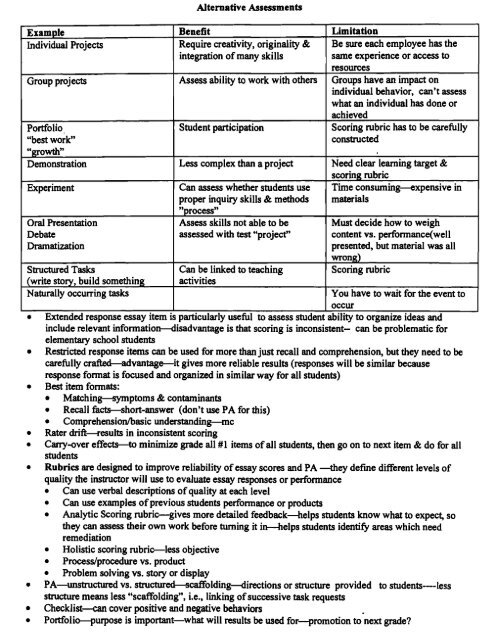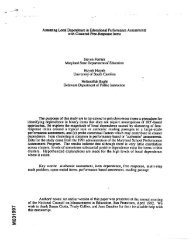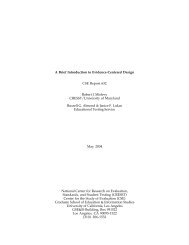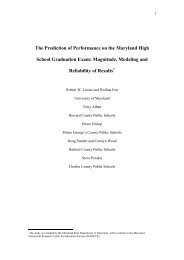Anonymous (XXXX) Rubric scoring and item writing.pdf
Anonymous (XXXX) Rubric scoring and item writing.pdf
Anonymous (XXXX) Rubric scoring and item writing.pdf
Create successful ePaper yourself
Turn your PDF publications into a flip-book with our unique Google optimized e-Paper software.
Alternative Assessments<br />
Example Benefit Limitation<br />
Individual Projects Require creativity, originality & Be sure each employee has the<br />
integration ofmany skills same experience or access to<br />
resources<br />
Group projects Assess ability to work with others Groups have an impact on<br />
individual behavior, can't assess<br />
what an individual has done or<br />
achieved<br />
Portfolio Student participation Scoring rubric has to be carefully<br />
"best work"<br />
constructed<br />
"growth" .<br />
Demonstration Less complex than a project Need clear learning target &<br />
<strong>scoring</strong> rubric<br />
Experiment Can assess whether students use Time consuming---expensive in<br />
proper inquiry skills & methods materials<br />
"process"<br />
Oral Presentation Assess skills not able to be Must decide how to weigh<br />
Debate assessed with test "project" content vs. performance(well<br />
Dramatization<br />
presented, but material was all<br />
wrong)<br />
Structured Tasks Can be linked to teaching Scoring rubric<br />
(write story, build something activities<br />
Naturally occurring tasks<br />
You have to wait for the event to<br />
occur<br />
• Extended response essay <strong>item</strong> is particularly useful to assess student ability to organize ideas <strong>and</strong><br />
include relevant infonnation--disadvantage is that <strong>scoring</strong> is inconsistent- can be problematic for<br />
elementary school students<br />
• Restricted response <strong>item</strong>s can be used for more than just rec~ll <strong>and</strong> comprehension, but they need to be<br />
carefully crafted-advantage-it gives more reliable results (responses will be similar because<br />
response fonnat is focused <strong>and</strong> organized in similar way for all students)<br />
• Best <strong>item</strong> formats:<br />
• Matching-symptoms & contaminants<br />
• Recall facts-short-answer (don't use PA for this)<br />
• Comprehension/basic underst<strong>and</strong>ing-mc<br />
• Rater drift---results in inconsistent <strong>scoring</strong><br />
• Carry-over effeets-to minimize grade all #1 <strong>item</strong>s ofall students, then go on to next <strong>item</strong> & do for all<br />
students<br />
• <strong>Rubric</strong>s are designed to improve reliability ofessay scores <strong>and</strong> PA -they define different levels of<br />
quality the instructor will use to evaluate essay responses or performance<br />
• Can use verbal descriptions ofquality at each level<br />
• Can use examples ofprevious students performance or products<br />
• Analytic Scoring rubrie-gives more detailed feedback-helps students know what to expect, so<br />
they can assess their own work before turning it in-helps students identify areas which need<br />
remediation<br />
• Holistic <strong>scoring</strong> rubric-less objective<br />
• Process/procedure vs. product<br />
• Problem solving vs. story or display<br />
• PA-unstructured vs. structured-scaffolding-directions or structure provided to students---less<br />
structure means less "scaffolding", i.e., linking ofsuccessive task requests<br />
• Checklist-can cover positive <strong>and</strong> negative behaviors ..<br />
• Portfolio-purpose is important-what will results be used for-promotion to next grade?






